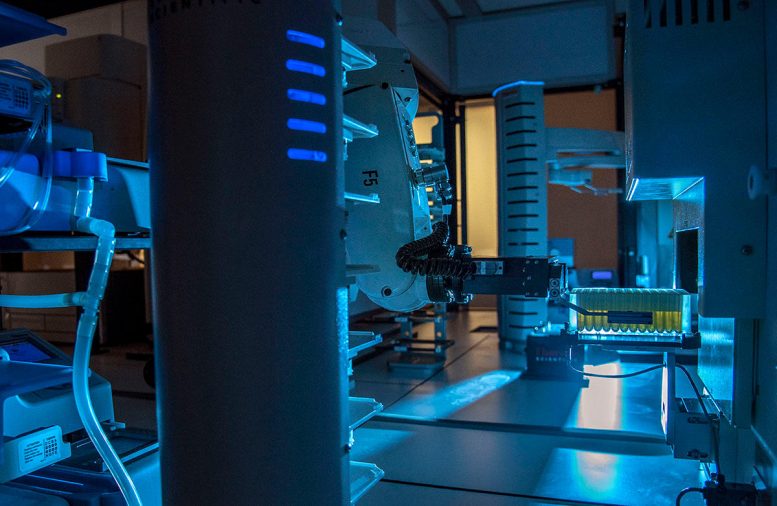
iBioFAB accelerates the biological engineering process by integrating artificial intelligence/machine learning with automation. Credit: Julia Pollack
Researchers were able to discover and characterize new ribosomally synthesized and post-translationally modified peptides at an unprecedented speed and scale.
Modern medicine makes extensive use of drugs that bacteria naturally produce. One of the most noteworthy natural products is penicillin, an antibiotic developed from certain molds that is regarded as one of the most significant developments in medicine and human health. Scientists now have access to hundreds of thousands of microbial genomes and the natural compounds they make as DNA sequencing has gotten more inexpensive and quick.
However, according to Doug Mitchell (MMG), the John and Margaret Witt Professor of Chemistry at the University of Illinois, this is insignificant when compared to the number of compounds that these organisms are capable of producing by using the genetic pathways they possess.
“This is just the tip of the iceberg,” said Mitchell. “There’s a disparity in what we know today in terms of known molecules versus what nature has the capacity to produce. Like 100 to one at least.”
Ribosomally produced and post-translationally modified peptides, or simply “RiPPs,” are one kind of natural product that has become a popular source of antibiotics. Traditional approaches for accessing RiPPs are laborious and include inserting each gene into a model organism, such as E. coli, one at a time, to observe what compound it produces. However, utilizing the Illinois Biological Foundry for Advanced Biomanufacturing, researchers were able to find and characterize new RiPPs at an unprecedented speed and scale in a recent study that was the outcome of a major joint effort at the Carl R. Woese Institute for Genomic Biology.
iBioFAB is a lab automation system that can analyze and create many synthetic gene pathways from hundreds of genes at once, a task that would typically need numerous researchers and a lot more time to do. This study is a partnership between Mitchell’s lab, the lab of Huimin Zhao (BSD/GSE leader/CABBI/CGD/MMG), the Steven L. Miller Chair of chemical and biomolecular engineering, and the lab of Wilfred van der Donk (MMG), Richard E. Heckert Endowed Chair in Chemistry and Howard Hughes Medical Institute Investigator.
In a new paper resulting from a massive collaborative effort at the University of Illinois Urbana-Champaign, researchers were able to discover and characterize new ribosomally synthesized and post-translationally modified peptides (RiPPs) at an unprecedented speed and scale using the Illinois Biological Foundry for Advanced Biomanufacturing. Credit: Carl R. Woese Institute for Genomic Biology, University of Illinois at Urbana-Champaign
The three co-first authors, Alex Battiste, a fourth-year Ph.D. student in the Mitchell lab, Chengyou Shi, a fifth-year Ph.D. candidate in the Zhao lab, and Richard Ayikpoe, a postdoc in the van der Donk lab, described how they each led a part of the project in their respective labs. Shi’s team ordered synthetic genes and then assembled them into candidate pathways, or gene clusters, using iBioFAB integrated with a genome mining program called RODEO. Then, different classes of the gene clusters were given to Battiste and Ayikpoe’s teams to test which pathways were functional and likely to produce new RiPPs in E. coli. Any structures of RiPPs that showed antibiotic activities were characterized in detail by Ayikpoe’s team. The high-throughput technology allowed for 96 pathways comprised of about 400 genes to be tested at once, with the production of 30 new compounds.
“Compared with traditional RiPP discovery methods, our platform is scalable and high-throughput in many aspects, from the biosynthetic gene cluster identification, the cloning, the production, and detection and characterization,” said Shi. “This, I would say, is the first such platform for large-scale RiPP discovery.”
Out of the new compounds discovered, three were found to have antibacterial properties. When tested against Klebsiella pneumoniae, which are highly virulent antibiotic-resistant bacteria, the newly discovered antibacterial RiPPs were found to be effective at killing the dangerous bacteria. The researchers say this could be a new avenue for discovering compounds that are effective against bacteria that are resistant to current antibiotic drugs.
“We found three RiPPs that have antimicrobial properties against pathogens that are known to be involved in hospital-acquired infections, including Klebsiella,” said Ayikpoe. “This research shows that by using this platform to extend the number of biosynthetic gene clusters that we can screen at once, we are more likely to discover anti-microbial compounds that could have therapeutic properties.”
The team says the goal of the paper is two-fold: to demonstrate the ability of the high-throughput technology to quickly construct and test gene clusters for new RiPPs, but also to emphasize the kind of large-scale collaborative projects that are made possible within the IGB. “There’s no way that any one of our labs could have done all of this on their own. The IGB has provided the crucible for this kind of interdisciplinary research,” Mitchell said.
Battiste described how the IGB inspires collaborative projects like this one naturally through its design. “The IGB makes it very easy to just talk to people when you see them all the time in your theme, which lowers the barrier for starting projects with them,” Battiste said. “Everyone in the MMG theme works on similar stuff even if we’re from different labs. So we all have different types of expertise but they mesh well together, and you get to learn about the types of techniques they’re using. It’s been one of my favorite parts of working here, the sense of camaraderie amongst all of the people on the team.”
All three co-first authors described how their education, research, and job prospects have benefitted greatly from their time at the IGB, highlighting that it is both the people and the technology together that make IGB a great place to conduct research. “The collaborative atmosphere that the IGB offers in diversity and growth, both in terms of science and social life, is really remarkable,” said Ayikpoe.
Reference: “A scalable platform to discover antimicrobials of ribosomal origin” by Richard S. Ayikpoe, Chengyou Shi, Alexander J. Battiste, Sara M. Eslami, Sangeetha Ramesh, Max A. Simon, Ian R. Bothwell, Hyunji Lee, Andrew J. Rice, Hengqian Ren, Qiqi Tian, Lonnie A. Harris, Raymond Sarksian, Lingyang Zhu, Autumn M. Frerk, Timothy W. Precord, Wilfred A. van der Donk, Douglas A. Mitchell, and Huimin Zhao, 17 October 2022, Nature Communications.
DOI: 10.1038/s41467-022-33890-w
The study was funded by the National Institutes of Health.


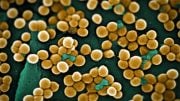
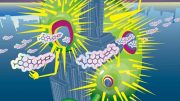

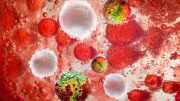
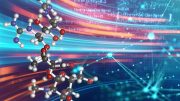
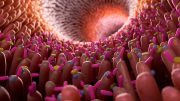
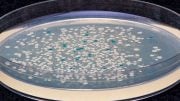
Why does every article use the word ‘scientist’ to describe every researcher and professional? How about using words such as ‘chemist’,’physicist’,’astronomer’,’biologist’,’engineers’,and so on – its as if they think their readers are in elementary school!